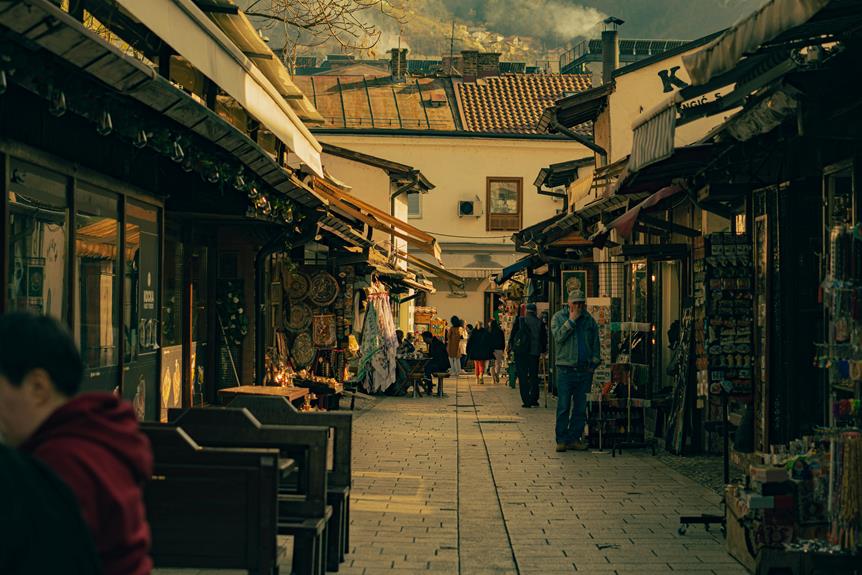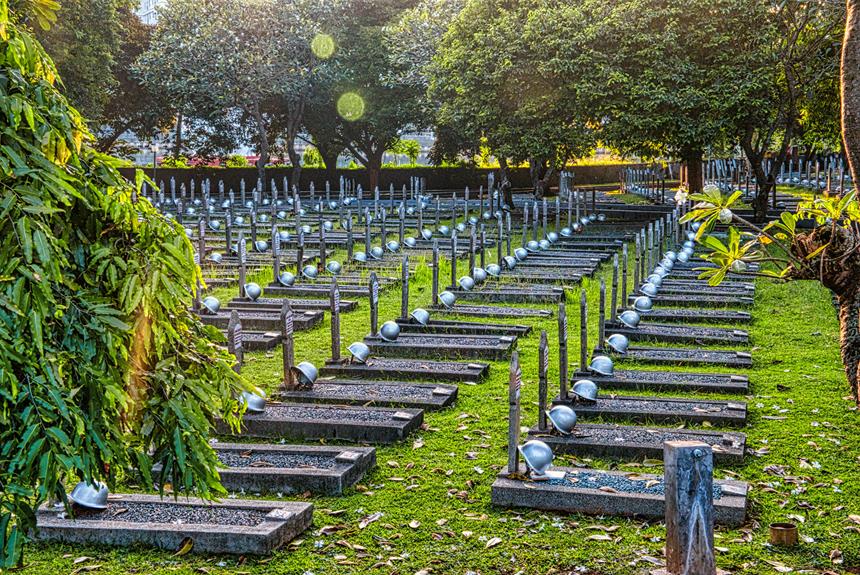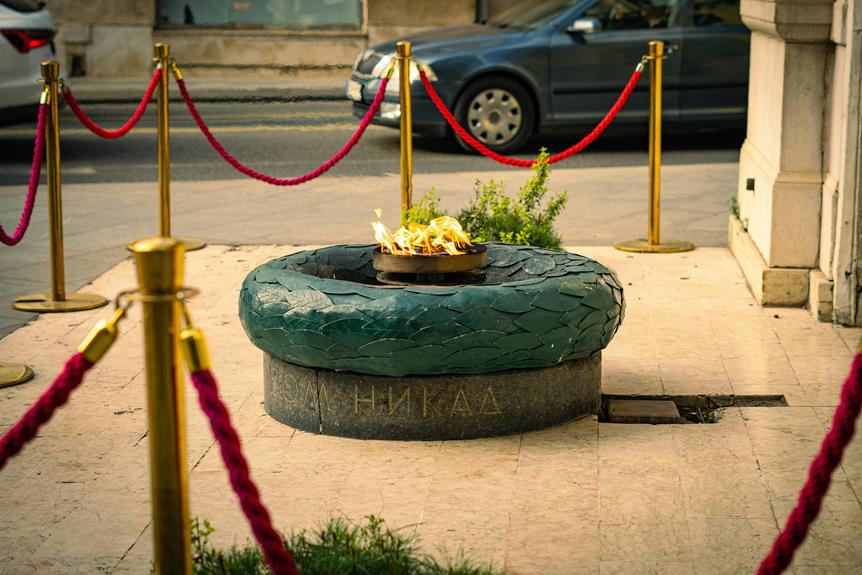The Srebrenica-Potočari Memorial in Bosnia and Herzegovina stands as a poignant reminder of the atrocities that unfolded during the Srebrenica Genocide. Its architectural significance and the emotional depth conveyed through the Memorial Wall of Names provide visitors with a space for contemplation and remembrance. However, beyond its physical presence lies a complex narrative of resilience and the pursuit of justice that warrants exploration. As we consider the impact of such memorial sites on societies and the global community, it becomes evident that the Srebrenica-Potočari Memorial is not merely a place of reflection but a catalyst for important conversations and actions.
Key Takeaways
- Memorial complex in Bosnia honoring over 8,000 genocide victims.
- Modern design integrates with surroundings for reflection.
- Memorial Wall of Names symbolizes individual lives lost.
- Educational exhibits provide historical context and interactive experiences.
- Annual events, ceremonies, and artistic performances honor victims and promote healing.
History of Srebrenica Genocide
The Srebrenica genocide, occurring in July 1995 during the Bosnian War, stands as one of the most brutal episodes of ethnic cleansing in recent history. The causes of this tragic event can be traced back to the breakup of Yugoslavia, leading to ethnic tensions and the desire for territorial control. The town of Srebrenica, designated a 'safe area' by the United Nations, became a refuge for Bosniak Muslims fleeing Serb forces. However, in a systematic campaign, Bosnian Serb forces under General Ratko Mladic overran Srebrenica, leading to the mass execution of over 8,000 Bosniak men and boys. The consequences of this genocide were devastating, leaving families shattered, communities torn apart, and a scar on the conscience of the international community.
The Srebrenica genocide had long-lasting effects on the region, deepening ethnic divisions and fueling further violence. The failure of the international community, particularly the Dutch peacekeepers tasked with protecting the safe area, to prevent the massacre highlighted the inadequacies of peacekeeping missions in the face of such atrocities. The aftermath of the genocide saw efforts to bring the perpetrators to justice, including the establishment of the International Criminal Tribunal for the former Yugoslavia. The Srebrenica genocide serves as a stark reminder of the horrors of ethnic violence and the urgent need to uphold human rights and prevent such atrocities from happening again.
Architecture of Memorial Complex
Incorporating symbolic elements and modern design principles, the Memorial Complex at Srebrenica-Potočari in Bosnia and Herzegovina stands as a poignant tribute to the victims of the Srebrenica genocide. The architectural design of the complex is characterized by its somber yet dignified aesthetics, reflecting the solemnity of the site's history. The structures within the complex are built to evoke a sense of reverence and reflection, with clean lines and minimalist features that emphasize the importance of remembrance.
Furthermore, the integration of the memorial within the surrounding landscape is a key aspect of the design. The architects have carefully considered the natural environment, incorporating elements that harmonize with the peaceful surroundings while also creating a space for contemplation and mourning. This landscape integration enhances the overall atmosphere of the memorial, providing visitors with a serene and contemplative environment in which to pay their respects.
Memorial Wall of Names
Symbolizing the individual lives lost during the Srebrenica genocide, the Memorial Wall of Names at Srebrenica-Potočari stands as a vital tribute to the tragic events that unfolded. The wall, stretching over 100 meters long, is inscribed with the names of over 8,000 victims who lost their lives during the genocide. Each name represents a person who was taken away too soon, a stark reminder of the human toll of the atrocities committed.
This powerful memorial offers a space for interactive engagement, allowing visitors to trace the names of the victims with their fingers, feeling the weight of each life lost. This tactile experience creates a profound connection between the visitors and the individuals memorialized on the wall, fostering a sense of empathy and remembrance.
Moreover, the Memorial Wall of Names plays an essential role in community healing. By honoring the victims and ensuring that their names are never forgotten, the memorial helps to acknowledge the pain and suffering endured by the survivors and their families. It serves as a place for reflection and contemplation, encouraging dialogue and understanding among visitors from all walks of life.
Potocari Cemetery Visit
During a visit to the Potocari Cemetery in Bosnia and Herzegovina, visitors are confronted with the solemn reality of the lives lost during the Srebrenica genocide. The cemetery serves as a poignant reminder of the atrocities that occurred in July 1995. Here, personal reflections intertwine with the cultural significance of the site, creating a profound experience for those who pay their respects.
- Emotional Impact: The rows of white gravestones evoke a deep sense of sadness and mourning, prompting visitors to reflect on the tragic events that transpired.
- Symbolism: Each gravestone represents a life cut short, a family torn apart, and a community devastated, symbolizing the immense loss suffered during the genocide.
- Historical Context: Understanding the historical context of the Srebrenica genocide enriches the visit, providing insight into the complex factors that led to such a horrific event.
- Cultural Remembrance: The cemetery stands as a tribute to the importance of remembering the past and honoring the victims, preserving their memory for future generations.
- Unity and Solidarity: Visitors often come together in solidarity, offering support to one another and reaffirming the shared commitment to never forget the lives lost at Srebrenica.
Educational Exhibits and Museums
The exploration of educational exhibits and museums related to the Srebrenica genocide in Bosnia and Herzegovina offers visitors a thorough understanding of the historical context and the impact of the atrocities committed during that period. These educational spaces provide interactive installations and multimedia experiences that engage visitors on a deep level, allowing them to immerse themselves in the history and testimonies of survivors.
One such museum is the Srebrenica Memorial Room, located within the Potocari Memorial and Cemetery. This room houses a collection of personal belongings, photographs, and documents that belonged to the victims, serving as a poignant reminder of the lives lost during the genocide. Visitors can also access multimedia presentations that detail the events leading up to the massacre, providing a comprehensive overview of the historical background.
Additionally, the Srebrenica Genocide Memorial Center in Potocari offers a detailed educational experience through its exhibits and displays. Interactive installations allow visitors to engage with the material in a hands-on manner, facilitating a more profound connection with the stories of the victims and the survivors. Through these immersive experiences, visitors gain a deeper insight into the tragic events that unfolded in Srebrenica, highlighting the importance of remembrance and reconciliation in the pursuit of peace and justice.
Commemorative Events and Ceremonies
Several annual commemorative events and ceremonies are held in Bosnia and Herzegovina to honor the victims of the Srebrenica genocide and to pay tribute to their memory. These events play an essential role in the healing process of the community and provide vital support to those affected by the tragedy.
Some key aspects of these commemorative events include:
- Memorial Services: Each year, memorial services are organized to remember the victims of the Srebrenica genocide. These services often involve religious leaders, government officials, and community members coming together to offer prayers and reflect on the impact of the tragedy.
- March of Peace: The March of Peace is a significant event where participants walk along the path that many Bosnian Muslims took while attempting to escape the genocide. This march symbolizes resilience, remembrance, and solidarity with the victims and their families.
- Candlelight Vigils: Candlelight vigils are held to honor the memory of the victims. Participants light candles as a symbol of hope, peace, and remembrance, fostering a sense of unity and support within the community.
- Educational Workshops: In addition to solemn ceremonies, educational workshops are conducted to raise awareness about the Srebrenica genocide, its historical context, and the importance of preventing such atrocities in the future.
- Artistic Performances: Artistic performances, including music, theater, and poetry, are often part of these commemorative events. These performances serve as a way to express emotions, share stories, and promote healing through creative expression.
Reflections on Tragedy and Loss
Reflections on the tragedy and loss experienced during the Srebrenica genocide evoke a profound sense of sorrow and collective mourning among individuals and communities affected by the devastating events. The personal healing process following such immense trauma is a challenging journey that requires time, understanding, and support. Simultaneously, community remembrance plays an important role in guaranteeing that the memories of the victims are honored and preserved for future generations.
To visually represent the interplay between personal healing and community remembrance, the following table outlines key aspects of each concept:
| Personal Healing | Community Remembrance |
|---|---|
| * Involves individual coping mechanisms and psychological recovery processes. | * Focuses on collective rituals, memorials, and events that honor the victims. |
| * Requires counseling, therapy, and self-reflection to address trauma. | * Involves the establishment of museums, memorials, and educational programs to preserve the memory of the genocide. |
| * Often includes seeking justice and accountability for the atrocities committed. | * Encourages community dialogue, storytelling, and sharing of experiences to make sure that the collective memory remains vivid. |
| * Aims to find meaning and resilience in the face of profound loss and suffering. | * Serves as a form of resistance against historical revisionism and denial of the genocide. |
Through a combination of personal healing and community remembrance, individuals and societies can navigate the complex emotions and challenges stemming from the Srebrenica genocide, fostering a sense of solidarity, resilience, and hope for a more just future.
Importance of Remembering
An essential aspect of preserving historical memory and preventing the recurrence of atrocities lies in the deliberate act of commemorating and acknowledging past tragedies. Remembering serves as a vital tool for collective healing and cultural preservation, guaranteeing that the lessons of the past are not forgotten.
- Honoring the Victims: By remembering and acknowledging the victims of past tragedies, we pay tribute to their lives and make certain that their stories are not lost to history.
- Educational Tool: Memorials serve as educational instruments, allowing future generations to learn about the atrocities that occurred and understand the consequences of hatred and intolerance.
- Promoting Empathy: Remembering past tragedies fosters empathy and compassion, encouraging individuals to stand against injustice and work towards a more peaceful world.
- Preventing Historical Amnesia: By actively remembering and commemorating past atrocities, we prevent historical amnesia and ensure that the truth is not obscured or forgotten.
- Fostering Unity: Remembering past tragedies can bring communities together, fostering unity in the face of shared grief and promoting a sense of solidarity in working towards a better future.
Ways to Support Memorial Efforts
To strengthen memorial efforts effectively, it is crucial to establish robust community engagement and sustainable financial support mechanisms. One way to support the Srebrenica-Potočari Memorial is through fundraising campaigns. These campaigns can be organized at local, national, and international levels to raise funds for the maintenance and development of the memorial site. By involving individuals, organizations, and businesses in fundraising efforts, the memorial can secure a steady stream of financial support to preserve the memory of the Srebrenica genocide.
Moreover, providing volunteer opportunities at the memorial site can also enhance support for memorial efforts. Volunteers can assist in various tasks such as guiding visitors, maintaining the grounds, and organizing educational programs. Through volunteering, individuals can actively contribute to the preservation of the memorial and engage with the history of the Srebrenica genocide on a more personal level. This hands-on involvement helps create a sense of ownership and connection to the memorial, fostering long-term support from the community.
Frequently Asked Questions
How Has the Local Community Been Involved in Maintaining the Memorial?
Community involvement in preserving memorials is essential for their longevity. Local residents often volunteer to maintain sites, organize events, and educate visitors. Their dedication guarantees that the memorial remains a poignant reminder of historical events.
Preservation efforts are sustained through collaborative initiatives, funding drives, and partnerships with organizations. By actively engaging with the memorial, the local community plays an important role in honoring the memory of those affected and preserving the site for future generations.
Are There Any Initiatives in Place to Support Survivors of the Genocide?
In response to the Current Question, initiatives like support programs and healing initiatives have been implemented to aid survivors of the genocide.
These programs offer various forms of assistance, including psychological support, access to healthcare, and community-building activities.
What Is the Significance of the Memorial Wall of Names?
The memorial wall of names holds immense significance in fostering remembrance, healing, and unity. It serves as a powerful symbol of the importance of honoring the lives lost during tragic events.
How Does the Memorial Address the Issue of Reconciliation in Bosnia?
In addressing reconciliation efforts in Bosnia, the memorial strategically involves the community by providing a space for collective remembrance and reflection.
Through commemorating the victims and acknowledging the atrocities, the memorial facilitates dialogue, healing, and understanding among different groups.
Are There Any Plans for Expanding the Educational Programs at the Memorial?
At present, there are endeavors to broaden the educational programs offered by the memorial through expanding programs and implementing new educational initiatives. These developments aim to enhance the depth and scope of educational opportunities available to visitors, fostering greater awareness and understanding of the historical significance and lessons associated with the site.
Such expansions are crucial in promoting learning, reflection, and dialogue on the issues encompassed by the memorial.
Conclusion
To sum up, the Srebrenica-Potočari Memorial in Bosnia and Herzegovina stands as a somber reminder of the atrocities committed during the Srebrenica Genocide. Through its symbolic architecture and commemorative elements, the memorial serves as a poignant tribute to the thousands of lives lost.
Visitors are encouraged to reflect on the past and honor the victims, fostering a sense of unity and a collective commitment to never forget the tragic events that occurred.


